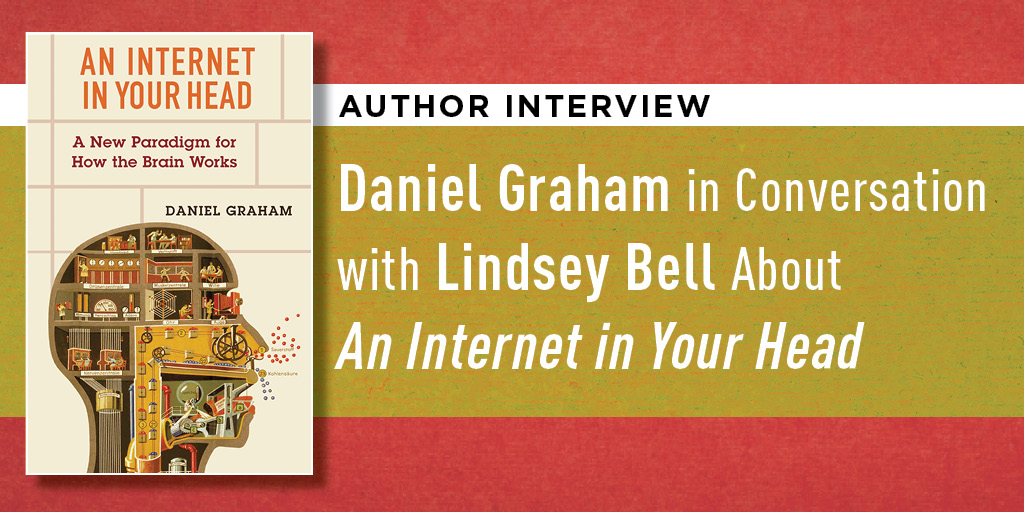Daniel Graham in Conversation with Lindsey Bell About An Internet in Your Head

The metaphor of the brain as a computer has defined the neuroscience field for much of the modern era. Whether we realize it or not, we think of our brains as computers. But as neuroscientists increasingly reevaluate their assumptions about how brains work, we need a new metaphor to help us ask better questions. Daniel Graham, author of An Internet in Your Head: A New Paradigm for How the Brain Works, is a computational neuroscientist and chair of psychological science at Hobart and William Smith Colleges. In this conversation with Lindsey Bell, Graham explains how the similarities between brain connectivity and the architecture of the internet open new avenues of research and help unlock the brain’s deepest secrets.
Lindsey Bell: Let’s start with learning a little more about you. What drew you to the field of computational neuroscience? What experiences and discoveries inspired you to write the book?
Daniel Graham: When I started graduate school in physics, I knew I wanted to study complex systems. These are the messy, weird systems of many elements that are well accounted for in traditional, reductionist science. But I had no idea what direction it would take me. By chance, I was introduced to neuroscience and was hooked. I started to work with David Field, who studies the basic architecture of the human visual system. I quickly found a universe of decidedly weird and complex phenomena that needed explaining.
The idea of an internet-like brain came later, as a side project, when I was a postdoctoral researcher with mathematician Dan Rockmore. Despite the fact that this had nothing to do with our main research on computer vision and art authentication, Dan helped nurture the idea that the brain and internet might be similar, resulting in a short paper we coauthored in 2011.
I kept thinking about this idea, and found more and more lines of correspondence between brains and the internet. After positive feedback from some generous colleagues, I was convinced it should be explored more fully. I was also worried someone else might beat me to it!
Bell: Your book offers an innovative paradigm for understanding the brain. What inspired the internet metaphor? How do communication and technology relate to the brain?
Graham: Growing up, there were always computers around. Once dial-up internet came along, it just seemed like a natural progression. At the time, I wasn’t interested in how computer networks worked—I just wanted to play video games! Internet infrastructure seemed boringly utilitarian to me.
That changed in graduate school. I took a part-time job as a researcher for Send, a popular book about email by David Shipley and Will Schwalbe. In researching the deep history of the internet, I encountered the rich theoretical infrastructure that makes email and everything else possible. Early pioneers like Paul Baran and Leonard Kleinrock came up with profound insights into the fundamental properties of communication, but received little fanfare at the time. Even today, they are not well known outside of
computer science circles. Baran, Kleinrock and others figured out how to move messages around a large network at will. They developed a conceptual infrastructure that allows flexible, fast, reliable, and robust communication.
What I learned about the internet struck me as uniquely relevant to brains. At a superficial level, the brain brings together computations in neurons, just as the internet brings together computations on individual devices. But the internet also has a bag of clever tricks for solving complex communication problems. Its architecture has proven remarkably effective and resilient through war, pandemic, and all kinds of crises. Of course, the brain’s system for organizing large-scale message transport among neurons is not identical to internet architecture. The point of An Internet in Your Head is to explore some of the basic tricks of network communication and to sketch out how similar strategies could be adapted and implemented in the brain.
Bell: Why use a metaphor at all? You’ve pointed out flaws in the computer and internet comparisons. Why not just say exactly what you mean and avoid using a metaphor built on incomplete data and potentially incorrect assumptions?
Graham: You are right to be wary of metaphor in science! Metaphor is no substitute for theory and experiment, and it can certainly lead us astray. But in trying to understand the fundamental nature of things, we often start with mental pictures—and with metaphor.
The mathematician Henri Poincaré said, “mathematics is the art of giving the same name to different things.” I think this is true for science more generally, at least as we start down a new direction of investigation. When we find a good metaphor, it helps us rule out large sectors of the space of possible answers to a problem. That is, to a scientist, metaphor doesn’t solve a problem. Metaphor says, “Look here, not over there.”
Metaphor also helps us see from a new perspective. We need to constantly reevaluate our metaphors and keep trying to conjure up better images. In physics, the metaphor of space as a rigid container in which events occur dominated the field for centuries. It helped us understand lots of phenomena in the world around us. But it turned out to be a misleading metaphor that led to contradictions. The container metaphor was displaced only when Einstein gave us a new metaphor: the bendable fabric of spacetime.
Bell: Please explain why technology is the best metaphor for the brain. Surely there must be a million ways to describe the brain, so why have scientists continued to use technological metaphors above all others?
Graham: Technological metaphor is useful especially in the biological sciences because both engineered technology and biological organisms have goals. Individual organisms and whole species are in competition with each other, and Darwinian evolution has given them strategies to achieve the competitive goals of reproduction and survival in a particular niche. In light of these goals, we are compelled to ask why systems are as they are. This is unlike physics, where the Moon or an electron has no goal to speak of. But in organisms subject to evolution, the “why” question gives us a lever to pry open the nut of the problem. When we bear in mind that technology is not engineered in the same way as life, we can profit from an engineering perspective.
Our understanding of the brain has progressed through adoption of a succession of technological metaphors. First, we had to see the brain as technology of any kind.
Descartes’s idea was that organisms and their brains are machines that do a job. He went further with metaphor and suggested that the brain’s job is plumbing, with the pineal gland in the center of the brain serving as that master valve, controlling thought and action. Descartes was wrong about how this plumbing works, but it is certainly the case that brains control thought and action in part through hydraulics. Systematically moving ions in fluid is a main job performed by neurons, and a job they are highly specialized for. Seeing the brain as a system involving flow, like a plumbing system, was a key step in our understanding, and allowed us to go beyond metaphor.
In the late nineteenth and early twentieth centuries, researchers developed a new metaphor, this time comparing the brain to telegraph and telephone systems. This helped us see that the brain’s networked nature was important.
But brain-wide communication was then—and remains today—very difficult to study empirically. Telephone networks also have very different architecture compared to brains. The metaphor was helpful, but it couldn’t explain everything.
Scientists moved on to the computer metaphor. This allowed them to focus on the computations performed in local regions and circuits of the brain without worrying about how messages traverse larger networks of neurons. More specifically, we have focused on representation—that is, the encoding of information—rather than on the transport of information. This has been very productive. Scientists have developed worthy models of certain types of computations, especially in certain parts of the visual system.
The internet metaphor aims to bring us back to a consideration of the brain’s communication problem, this time with a new and better set of analogized engineering strategies, which I hope will inspire new experimental approaches.
Bell: How has the internet metaphor helped to advance the field of neuroscience? Is there a tangible measure of its usefulness?
Graham: There are several competing movements aiming to understand the basic organization of brains. Some see the brain’s computation of statistics and the likelihood of events as its basic design goal: this is the brain as a predictive machine, computing probabilities of events in the world and in our bodies. We can look for some chunk of brain that produces neural responses that predict where a baseball will land. Success entails reading out and decoding computations in the relevant brain region. But what the brain does with this computation is not really examined.
Others have emphasized the brain’s dynamism and modeled neural activity as a dynamical system. Like an audience clapping, large numbers of neurons can come into sync and show patterns of coordination over time.
A third approach is communication models, which in some ways unify the brain’s computations and its dynamism. From this viewpoint, communication is what holds the whole thing together. We might find that internet-like communication strategies coordinate the brain’s other goals and interactions such as predictive computing and synchrony. But I would be very happy to see the internet metaphor replaced with more specific and quantitative models, even if they prove to be unlike the internet. One measure of the success of the internet metaphor will be if people try to prove it wrong.
Bell: You’ve explained how technological metaphors have had an impact on the field of neuroscience. Now tell me how the relationship between the brain and the internet has affected technology–specifically artificial intelligence?
Graham: The big thing missing in AI is flexibility. Computing—which is to say performing a series of mathematical operations—is about reliability and precision. You want one plus one to always equal exactly two. What sets the internet apart from other types of computing is that it is flexible. Part of this flexibility is in the kinds of information that can be exchanged on the network. The network really doesn’t care whether a given chunk of data corresponds to a piece of an email, a video call, or a bank transaction. Another kind of flexibility is in the way traffic is managed. There are many alternate routes for messages that encounter traffic en route. Our robust brains must also solve these kinds of problems: when we learn new things, we generate new flows of signals. But the network structure is largely static, so these new flows must coexist with older flows already associated with other knowledge and abilities. We should aim for AI that is flexible in similar ways.
There may already be an example of this kind of AI: the internet itself. Since I am saying that the internet uses communication strategies that could resemble how the brain works, we can invert the brain-as-internet metaphor and ask: how brain-like is the internet?
If the internet is like the brain, could it achieve things our brains accomplish, like awareness? It certainly has access to countless sensors and output mechanisms. It also has ways of monitoring itself and its network integrity—a kind of self-awareness. The internet’s quiddity and functionality are preserved even as the machines that compose it are replaced, and as the network grows. Likewise, our brains maintain a smooth and uninterrupted flow of experience.
I’m not saying the internet has awareness. But considering what it would take to declare the internet conscious can help us reexamine the nature of our own consciousness. It can also help us reimagine AI.
Bell: What should readers take away from the brain-as-internet metaphor? Is it useful only for research in neuroscience, or is there something for everyone to learn from the internet inside our heads?
Graham: I hope the internet metaphor will be useful for brain researchers, but it has implications for everyone. In daily life, we often imagine our brains as computers without realizing it. We invoke this metaphor anytime we say “I’m processing,” or “I need a reboot,” or “I’m hard-wired that way.” As in the research domain, these metaphors can help us cope with complexity. But seeing our brains as computers can also limit our everyday experience of having a brain.
Unlike rigid computing machines, our brains are a highly dynamic and flexible web of links and connections. Even in adulthood, our brains can be profoundly reshaped. Researcher Alvaro Pascual-Leone and his colleagues once took healthy, sighted people and blindfolded them for a few days. Pascual-Leone put participants in a brain scanner and tracked activity in their visual system, at the back of the head. On the first day, their visual systems kept themselves busy with hallucinations. But then Pascual-Leone started teaching the participants to read Braille with their fingers. Very quickly, there was strong activity coordinated between touch-related areas and vision-related areas in the brain while participants read Braille. In a neural sense, they had learned to see with their fingers instead of their eyes. This pattern disappeared again when the blindfold was removed. All of this happened on a network that can’t really change its structure in a few days. There had to be new patterns of traffic on old patterns of connection.
I’m not suggesting people blindfold themselves for long periods—the reported hallucinations can be very intense. But I hope people will appreciate just how flexible the network in our heads can be. The basic dynamism of the brain gives us a remarkable capacity for change, learning, and exploration across our lifespan. We should use this superpower more.






